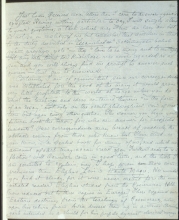Page 1
Just home. Received more letters than I care to answer — yours excepted. Having nothing particular to say, I will simply attend to your questions; a task which may seem an easy one, but is not so, in reality, if we but remember that similar in that to the deity described in Upanishad as "Sokāmayata bahuh syām prajāye yeti"—they "love to be many and to multiply." At any rate, thirst for knowledge was never regarded as a sin and you will always find me prompt to answer such queries—that can be answered.
Certainly I am of opinion that since our correspondence was established for the good of the many it would prove very little profitable to the world at large unless you do recast the teachings and ideas contained therein "in the form of an essay," not only on the occult philosophical view of creation but upon every other question. The sooner you begin your "future book" the better; for who can answer for unexpected incidents? Our correspondence may break off suddenly the obstacle coming from those who know best. Their mind—as you know, is a sealed book for many of us, and which no amount of "art magic" can break open. Further "aids to reflection" will however come in good time; and the little I am permitted to explain, may, I hope, prove more comprehensive than Eliphas Levi's Haute Magie. No wonder you find it cloudy, for it was never meant for the uninitiated reader. Eliphas studied from the Rosicrucian MSS. (now reduced to three copies in Europe). These expound our eastern doctrines from the teachings of Rosencranz, who, upon his return from Asia dressed them up in a semi-Christian garb intended as a shield for his pupils, against clerical revenge.



"The deity described in Upanishad" refers to Brahman's statement in the Taittirīya Upaniṣad (2.6.1): so 'kāmayata bahu syām prajāyeyeti, which can be translated as, "He desired—Let me become many, let me be born."